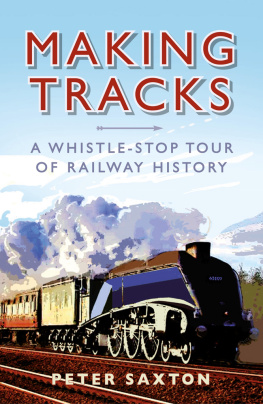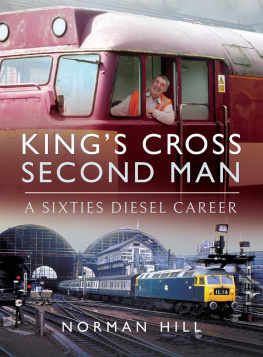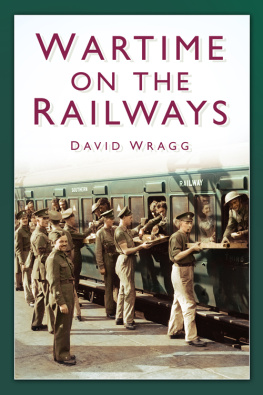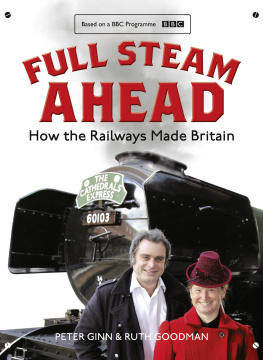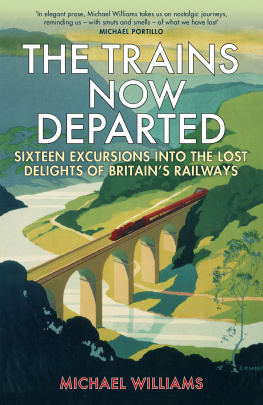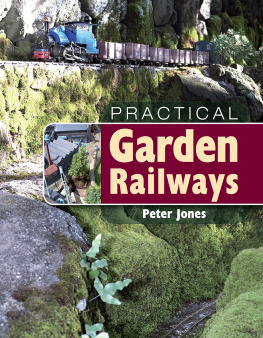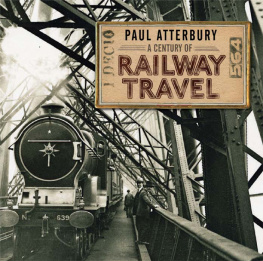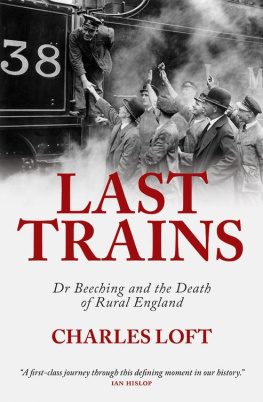First published in Great Britain in 2015
by Michael OMara Books Limited
9 Lion Yard
Tremadoc Road
London SW4 7NQ
Copyright Michael OMara Books Limited 2015
All rights reserved. You may not copy, store, distribute, transmit, reproduce or otherwise make available this publication (or any part of it) in any form, or by any means (electronic, digital, optical, mechanical, photocopying, recording or otherwise), without the prior written permission of the publisher. Any person who does any unauthorized act in relation to this publication may be liable to criminal prosecution and civil claims for damages.
A CIP catalogue record for this book is available from the British Library.
ISBN: 978-1-78243-329-3 in hardback print format
ISBN: 978-1-78243-332-3 in e-book format
Jacket design by Patrick Knowles
Illustrations by Aubrey Smith
Designed and typeset by Design 23, London
www.mombooks.com
For my mother, who always believes in me.
CONTENTS
R AILWAYS OCCUPY AN INTERESTING place in the public psyche. Endlessly complained about, discussed and used as an excuse for lateness in almost any circumstance, they are also loved, obsessed over and romanticized more than any other form of mass transport.
My own obsession, I am convinced, comes from my mother. Like many women today, although unlike a lot of women in the early 1960s, my mother continued working throughout her pregnancy. She would travel daily between our home in Wimbledon and her job as a cook in Sloane Square, bouncing on the springy cushions of the rattling, red-painted District line trains from the 1920s that were still doing sterling service at that time. After I was born, circumstances dictated that she had to return to work so she took me daily on the same journey right up until I started school. We would always (at my insistence) sit in the same seat, looking to the right so that I could gaze at the endless procession of main-line trains on the way to and from Waterloo. Trains that included fast, clattering expresses to Portsmouth; plodding, whining suburban sets that stopped at all stations to and from exciting day-trip destinations such as Chessington and Hampton Court; and, thrill of thrills, steam-hauled expresses bound for the Wessex coast. All painted the sober, attractive green that, quite frankly, is the colour trains should be.
I had no option other than to be completely hooked. Add to that a train-enthused father who would take me to the footbridge outside Wimbledon station to wave at the drivers (oh, the excitement of a wave back and sometimes a friendly toot) and you will understand that life conspired to make me a hopeless train freak.
This book is a brief history of railways and how different people came up with innovations and designs that cumulatively have led to the systems we have today. And how their individual genius combined in the one central genius that of railways themselves.

GAUGE MATTERS: OR WHY ARE THEIR TRAINS BIGGER THAN OURS?
I N ITS SIMPLEST FORM , a railway track consists of a pair of rails, held parallel by a series of structures known in the UK as sleepers and in the US as ties. This track is generally laid on a bed of ballast although in some cases it is fixed directly on to a concrete base. This latter method is known as slab track; it needs less maintenance and is used principally in areas that have very high usage or that are tricky to reach, such as tunnels. The track is sometimes referred to as the permanent way.
A railway gauge is, straightforwardly, the measurement of the space between the rails. The table below shows some of the more commonly used gauges in the world.
Width between the rails | Used in |
1,000 mm (metre gauge) | Brazil, Switzerland (many mountain railways), some African countries, south-east Asia |
1,067 mm (3 ft 6 in) | Some areas of Australia, Indonesia, Japan (except high-speed lines, which are standard gauge), many African countries, New Zealand |
1,435 mm (standard gauge) (4 ft 8 in) | Most widely used worldwide (approximately 60 per cent of railways) |
1,520 mm (5 ft) | Russia and some former Soviet states |
1,600 mm (5 ft 3 in) | Ireland and some areas of Australia |
1,668 mm (5 ft 5 in) | Spain and Portugal (except high-speed lines, which are standard gauge) |
1,676 mm (5 ft 6 in) | India, Pakistan, Argentina, Chile |
LOADING GAUGE
The track gauge alone is not the sole factor contributing to the overall size of the trains running along it. The loading gauge is the measure that defines the maximum size trains can be in order to operate safely, taking into account bridges, tunnels, stations and other trackside structures. The British loading gauge, with some limited exceptions, is one of the tightest relative to track gauge the British network, being the oldest in the world, is still suffering from the legacy of early mistakes and lack of central planning.
British rail users often return from continental Europe or the US raving about the wonders of double-deck trains and lamenting the lack of them at home. It is the loading gauge that is responsible; the continental, or Berne gauge, is much more generous than the UKs.

EARLY DAYS
The worlds first modern, double-tracked, steam-hauled railway was the Liverpool and Manchester, opened in 1830. Prior to that, the Stockton and Darlington had opened in 1825, also using steam technology for some of the time. However, this had proved unreliable so horses were often used instead, harking back to an earlier age of wagonways in which wooden and later iron rails had been laid to enable horses to pull heavy loads out of mines. These would then be sent along to shipment points with much greater ease than if they had been transported across bare ground or deep mud.
The concept of using specific tracks or grooves wasnt new even then the Ancient Greeks and Romans had dug out channels to help carts and wagons along their way without sliding. From the Middle Ages up to around the middle/end of the eighteenth century, both Germany and Britain had wagonways in their mining regions and the earliest rails (as opposed to grooves) appeared in Germany in the mid-sixteenth century.
Obviously its impossible to keep vehicles on rails without some sort of controlling device. Early rails used flanges (raised ridges or rims) to ensure that wagons didnt veer off. These flanges were later transferred to the inner edges of the wheels themselves and it is this method that has survived to the present. The idea of using rails for transportation, therefore, wasnt new by the early nineteenth century, but advances in technology meant that railways were about to experience an explosion in popularity. Hitherto, horse or indeed human power was the main form of traction (although some employed cables or gravity) but it was the development of steam that really got things going.
The steam engine began as a stationary machine that was used to drive water pumps, but it wasnt long before enterprising engineers found a way to connect it to wheels and therefore become self-propelling. As with railways themselves, the idea of using steam power wasnt new, but it was in the early nineteenth century that the technology really took off.

